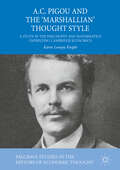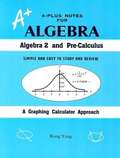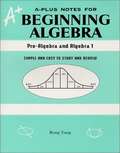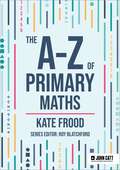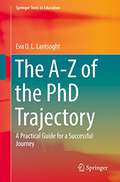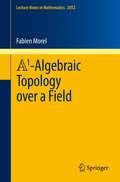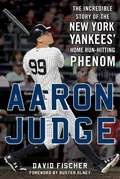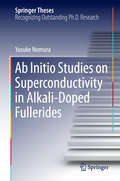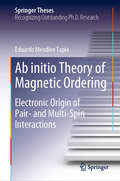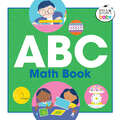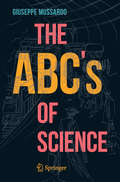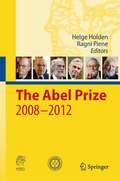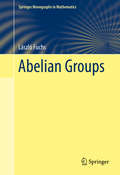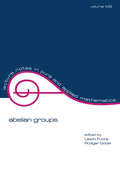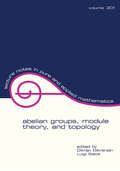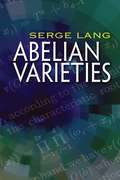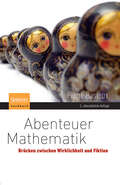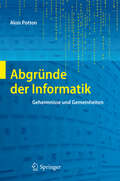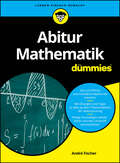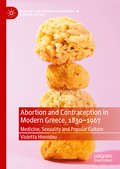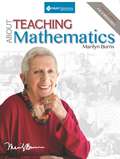- Table View
- List View
A.C. Pigou and the ‘Marshallian’ Thought Style: A Study In The Philosophy And Mathematics Underlying Cambridge Economics (Palgrave Studies In The History Of Economic Thought)
by Karen Lovejoy KnightThis book provides a study of the forces underlying the development of economic thought at Cambridge University during the late nineteenth century and the first half of the twentieth century. The primary lens it uses to do so is an examination of how Arthur Cecil Pigou’s thinking, heavily influenced by his predecessor, Alfred Marshall, evolved. <p><p> Aspects of Pigou’s context, biography and philosophical grounding are reconstructed and then situated within the framework of Ludwik Fleck’s philosophy of scientific knowledge, most notably by drawing on the notions of ‘thought styles’ and ‘thought collectives’. In this way, Knight provides a novel contribution to the history of Pigou's economic thought.
A-Plus Notes for Algebra: Algebra 2 and Pre-Calculus
by Rong YangSimple and Easy to Study and Review 1. It has 19,000 examples and exercises, from simple to complex. 2. It outlines the concepts, formulas, and theorems in algebra. 3. It facilitates the learning process in problem-solving. 4. It is good for SAT, ACT, GRE, GMAT, NTE and H.S Exit.
A-Plus Notes for Beginning Algebra: Pre-Algebra and Algebra 1
by Rong YangSimple and Easy to Study and Review 1. It has 19,000 examples and exercises, from simple to complex. 2. It outlines the concepts, formulas, and theorems in algebra. 3. It facilitates the learning process in problem-solving. 4. It is good for SAT, ACT, GRE, GMAT, NTE and H.S Exit.
The A-Z of Primary Maths (John Catt A-Z series)
by Kate FroodThe A-Z of Primary Maths is a compendium of great ideas for teaching mathematics, organised around the 26 letters of the English alphabet.'Maths foundations must be built in our primary schools. We need to create space for children to play with numbers, to explore patterns, to solve problems, and to laugh and chat in maths lessons. It's this start that will build a lifelong love of and confidence in maths' - Kate Frood.
The A-Z of Primary Maths (John Catt A-Z series)
by Kate FroodThe A-Z of Primary Maths is a compendium of great ideas for teaching mathematics, organised around the 26 letters of the English alphabet.'Maths foundations must be built in our primary schools. We need to create space for children to play with numbers, to explore patterns, to solve problems, and to laugh and chat in maths lessons. It's this start that will build a lifelong love of and confidence in maths' - Kate Frood.
The A-Z of the PhD Trajectory: A Practical Guide for a Successful Journey (Springer Texts In Education)
by Eva O. L. LantsoghtIs suitable for a classroom setting as well as for self-study.<P><P> Offers advice, anecdotes and exercises to teach junior PhD students in STEM how to succeed.<P> Provides information and suggested methods for all steps of the PhD trajectory.<P> Contains an extensive glossary of terms.<P>This textbook is a guide to success during the PhD trajectory. The first part of this book takes the reader through all steps of the PhD trajectory, and the second part contains a unique glossary of terms and explanation relevant for PhD candidates. Written in the accessible language of the PhD Talk blogs, the book contains a great deal of practical advice for carrying out research, and presenting one’s work. It includes tips and advice from current and former PhD candidates, thus representing a broad range of opinions. The book includes exercises that help PhD candidates get their work kick-started. It covers all steps of a doctoral journey in STEM: getting started in a program, planning the work, the literature review, the research question, experimental work, writing, presenting, online tools, presenting at one’s first conference, writing the first journal paper, writing and defending the thesis, and the career after the PhD. Since a PhD trajectory is a deeply personal journey, this book suggests methods PhD candidates can try out, and teaches them how to figure out for themselves which proposed methods work for them, and how to find their own way of doing things.
A1-Algebraic Topology over a Field (Lecture Notes in Mathematics #2052)
by Fabien MorelThis text deals with A1-homotopy theory over a base field, i.e., with the natural homotopy theory associated to the category of smooth varieties over a field in which the affine line is imposed to be contractible. It is a natural sequel to the foundational paper on A1-homotopy theory written together with V. Voevodsky. Inspired by classical results in algebraic topology, we present new techniques, new results and applications related to the properties and computations of A1-homotopy sheaves, A1-homology sheaves, and sheaves with generalized transfers, as well as to algebraic vector bundles over affine smooth varieties.
Aaron Judge: The Incredible Story of the New York Yankees' Home Run–Hitting Phenom
by Buster Olney David FischerAt 6-foot-7 and 285 pounds, Aaron Judge emerged as the biggest story in baseball in 2017 with his monstrous home runs and record-breaking ability. A three-sport athlete in high school and a Division I ballplayer at Fresno State, the Californian was drafted by the New York Yankees in the first round in 2013 and made it to the majors by August 2016. Homering in his first major league at-bat and starting in right field straight out of spring training in 2017, he gave Yankees fans hope for the future, along with "Baby Bombers" teammates such as Gary Sanchez.After a rough start in which he batted below .200 and struck out in over 40 percent of his plate appearances after joining the Yankees, Judge turned things around and helped get his team off to a fast start in 2017 with 10 homers in April alone, tying the rookie record for the month. He then broke the legendary Joe DiMaggio’s team record for most round trippers by the All-Star break with 30, including one that measured at 495 feet. His mounting popularity enabled him to receive more All-Star votes than any American League player and to the creation of the "Judge's Chambers" section located in the right-field stands of Yankee Stadium. Judge's momentum next led to him winning the 2017 Home Run Derby where he smashed a total of 47, four of which traveled more than 500 feet. It's no wonder that baseball commissioner Rob Manfred has said that Judge is a player "who can become the face of the game." In Aaron Judge: The Incredible Story of the New York Yankees' Home Run-Hitting Phenom, David Fischer brings the exciting story of the Yankees' newest superstar to life.
Ab Initio Studies on Superconductivity in Alkali-Doped Fullerides (Springer Theses)
by Yusuke NomuraThis book covers high-transition temperature (Tc) s-wave superconductivity and the neighboring Mott insulating phase in alkali-doped fullerides. The author presents (1) a unified theoretical description of the phase diagram and (2) a nonempirical calculation of Tc. For these purposes, the author employs an extension of the DFT+DMFT (density-functional theory + dynamical mean-field theory). He constructs a realistic electron-phonon-coupled Hamiltonian with a newly formulated downfolding method. The Hamiltonian is analyzed by means of the extended DMFT. A notable aspect of the approach is that it requires only the crystal structure as a priori knowledge. Remarkably, the nonempirical calculation achieves for the first time a quantitative reproduction of the experimental phase diagram including the superconductivity and the Mott phase. The calculated Tc agrees well with the experimental data, with the difference within 10 K. The book provides details of the computational scheme, which can also be applied to other superconductors and other phonon-related topics. The author clearly describes a superconducting mechanism where the Coulomb and electron-phonon interactions show an unusual cooperation in the superconductivity thanks to the Jahn-Teller nature of the phonons.
Ab initio Theory of Magnetic Ordering: Electronic Origin of Pair- and Multi-Spin Interactions (Springer Theses)
by Eduardo Mendive TapiaMany technological applications exploit a variety of magnetic structures, or magnetic phases, to produce and optimise solid-state functionality. However, most research advances are restricted to a reduced number of phases owing to computational and resource constraints. This thesis presents an ab-initio theory to efficiently describe complex magnetic phases and their temperature-dependent properties. The central assumption is that magnetic phases evolve slowly compared with the underlying electronic structure from which they emerge. By describing how the electronic structure adapts to the type and extent of magnetic order, a theory able to describe multi-spin correlations and their effect on the magnetism at finite temperature is obtained. It is shown that multi-spin correlations are behind the temperature and magnetic field dependence of the diverse magnetism in the heavy rare earth elements. Magnetically frustrated Mn-based materials and the effect of strain are also investigated. These studies demonstrate that the performance of solid-state refrigeration can be enhanced by multi-spin effects.
Abacus Basic Competency: A Counting Method
by Susan M. MillawayLearn the parts of an abacus, how to "set" numbers and how to do calculations! There are competency tests with answers in the back of the book.
The Abacus Made Easy: A Simplified Manual for Teaching the Cranmer Abacus
by Mae E DavidowFrom the book: At Overbrook, [School for the Blind] Dr. Davidow was instrumental in establishing the use of the Cranmer Abacus as a part of the regular curriculum. Her enthusiasm for this pioneer method of teaching mathematics led others to adopt the use of the abacus. In her role as coordinating teacher, she worked with the members of the Mathematics Department and the results were highly successful. Hopeful that this success at Overbrook might be experienced by many teachers elsewhere, she was encouraged to write this manual. Her goal was to write a clear, simple manual which could be used by teachers or students. This book represents her achievement.
ABC Math Book (STEAM Baby for Infants and Toddlers)
by Dori Roberts StewartHelp your little one learn letters and math together—an ABC math book for kids ages 0 to 3 Give your little learner a jump-start with this fun, inspiring way to master their ABCs. From Abacus to Zero, this ABC book introduces young children to foundational mathematical concepts with each letter of the alphabet, doubling the learning and fun while giving your toddler a head start on their education. The ABC Math Book features: Levels of discovery—Explore a tiered learning approach that grows with your child. Focus first on letters, then words, and finally, understanding concepts. Colorful images—Keep your child engaged with rich and vibrant illustrations that add to their learning. Full S.T.E.A.M. ahead—Encourage a lifelong love of learning with all the books in the S.T.E.A.M. Baby series. Foster an excitement for learning in your little one with this fun exploration of letters and mathematical concepts.
The ABC’s of Science
by Giuseppe MussardoScience, with its inherent tension between the known and the unknown, is an inexhaustible mine of great stories. Collected here are twenty-six among the most enchanting tales, one for each letter of the alphabet: the main characters are scientists of the highest caliber most of whom, however, are unknown to the general public.This book goes from A to Z. The letter A stands for Abel, the great Norwegian mathematician, here involved in an elliptic thriller about a fundamental theorem of mathematics, while the letter Z refers to Absolute Zero, the ultimate and lowest temperature limit, - 273,15 degrees Celsius, a value that is tremendously cooler than the most remote corner of the Universe: the race to reach this final outpost of coldness is not yet complete, but, similarly to the history books of polar explorations at the beginning of the 20th century, its pages record successes, failures, fierce rivalries and tragic desperations. In between the A and the Z, the other letters of the alphabet are similar to the various stages of a very fascinating journey along the paths of science, a journey in the company of a very unique set of characters as eccentric and peculiar as those in Ulysses by James Joyce: the French astronomer who lost everything, even his mind, to chase the transits of Venus; the caustic Austrian scientist who, perfectly at ease with both the laws of psychoanalysis and quantum mechanics, revealed the hidden secrets of dreams and the periodic table of chemical elements; the young Indian astrophysicist who was the first to understand how a star dies, suffering the ferocious opposition of his mentor for this discovery. Or the Hungarian physicist who struggled with his melancholy in the shadows of the desert of Los Alamos; or the French scholar who was forced to hide her femininity behind a false identity so as to publish fundamental theorems on prime numbers. And so on and so forth.Twenty-six stories, which reveal the most authentic atmosphere of science and the lives of some of its main players: each story can be read in quite a short period of time -- basically the time it takes to get on and off the train between two metro stations. Largely independent from one another, these twenty-six stories make the book a harmonious polyphony of several voices: the reader can invent his/her own very personal order for the chapters simply by ordering the sequence of letters differently. For an elementary law of Mathematics, this can give rise to an astronomically large number of possible books -- all the same, but - then again - all different. This book is therefore the ideal companion for an infinite number of real or metaphoric journeys.
ABC's of Science
by Charles A. OliverThis books is about alpha, beta, and gamma. These are the first three letters of the Greek alphabet. <P> <P> This alphabet was the major method of written communication in ancient times, and is of course still used today. The Greek letters are also the most commonly used symbols in science. In all branches of science, we use symbols to represent ideas and definitions. Symbols serve to simplify communication and calculations—once you get used to them, that is.
The Abel Prize 2008-2012 (The Abel Prize)
by Helge Holden Ragni PieneCovering the years 2008-2012, this book profiles the life and work of recent winners of the Abel Prize: · John G. Thompson and Jacques Tits, 2008 · Mikhail Gromov, 2009 · John T. Tate Jr. , 2010 · John W. Milnor, 2011 · Endre Szemerédi, 2012. The profiles feature autobiographical information as well as a description of each mathematician's work. In addition, each profile contains a complete bibliography, a curriculum vitae, as well as photos -- old and new. As an added feature, interviews with the Laureates are presented on an accompanying web site (http://extras. springer. com/). The book also presents a history of the Abel Prize written by the historian Kim Helsvig, and includes a facsimile of a letter from Niels Henrik Abel, which is transcribed, translated into English, and placed into historical perspective by Christian Skau. This book follows on The Abel Prize: 2003-2007, The First Five Years (Springer, 2010), which profiles the work of the first Abel Prize winners.
Abelian Groups (Springer Monographs in Mathematics)
by László FuchsWritten by one of the subject's foremost experts, this book focuses on the central developments and modern methods of the advanced theory of abelian groups, while remaining accessible, as an introduction and reference, to the non-specialist. It provides a coherent source for results scattered throughout the research literature with lots of new proofs. The presentation highlights major trends that have radically changed the modern character of the subject, in particular, the use of homological methods in the structure theory of various classes of abelian groups, and the use of advanced set-theoretical methods in the study of un decidability problems. The treatment of the latter trend includes Shelah's seminal work on the un decidability in ZFC of Whitehead's Problem; while the treatment of the former trend includes an extensive (but non-exhaustive) study of p-groups, torsion-free groups, mixed groups and important classes of groups arising from ring theory. To prepare the reader to tackle these topics, the book reviews the fundamentals of abelian group theory and provides some background material from category theory, set theory, topology and homological algebra. An abundance of exercises are included to test the reader's comprehension, and to explore noteworthy extensions and related sidelines of the main topics. A list of open problems and questions, in each chapter, invite the reader to take an active part in the subject's further development.
Abelian Groups
by Laszlo Fuchs Rüdiger GöbelThis volume contains information offered at the international conference held in Curacao, Netherlands Antilles. It presents the latest developments in the most active areas of abelian groups, particularly in torsion-free abelian groups.;For both researchers and graduate students, it reflects the current status of abelian group theory.;Abelian Groups discusses: finite rank Butler groups; almost completely decomposable groups; Butler groups of infinite rank; equivalence theorems for torsion-free groups; cotorsion groups; endomorphism algebras; and interactions of set theory and abelian groups.;This volume contains contributions from international experts. It is aimed at algebraists and logicians, research mathematicians, and advanced graduate students in these disciplines.
Abelian Groups, Module Theory, and Topology: Proceedings In Honor Of Adalberto Orsatti's 60th Birthday (Lecture Notes in Pure and Applied Mathematics #Vol. 201)
by Dikran Dikranjan Luigi SalceFeatures a stimulating selection of papers on abelian groups, commutative and noncommutative rings and their modules, and topological groups. Investigates currently popular topics such as Butler groups and almost completely decomposable groups.
Abelian Varieties (Dover Books on Mathematics)
by Serge LangBased on the work in algebraic geometry by Norwegian mathematician Niels Henrik Abel (1802–29), this monograph was originally published in 1959 and reprinted later in author Serge Lang's career without revision. The treatment remains a basic advanced text in its field, suitable for advanced undergraduates and graduate students in mathematics. Prerequisites include some background in elementary qualitative algebraic geometry and the elementary theory of algebraic groups.The book focuses exclusively on Abelian varieties rather than the broader field of algebraic groups; therefore, the first chapter presents all the general results on algebraic groups relevant to this treatment. Each chapter begins with a brief introduction and concludes with a historical and bibliographical note. Topics include general theorems on Abelian varieties, the theorem of the square, divisor classes on an Abelian variety, functorial formulas, the Picard variety of an arbitrary variety, the I-adic representations, and algebraic systems of Abelian varieties. The text concludes with a helpful Appendix covering the composition of correspondences.
Abenteuer Mathematik: Brücken zwischen Wirklichkeit und Fiktion
by Pierre BasieuxNicht Mathematik zu betreiben, sondern zu erfahren ist das Abenteuer, das dieses Buch bietet - Denkexpeditionen, deren Ausgangspunkt Fragen sind: Was steckt hinter mathematischen Fiktionen wie den unendlich vielen Stufen des Unendlichen oder dem Letzten Fermatschen Satz? Worin liegt ihre Schönheit, worin ihr Bezug zur Realität? Welchen Köpfen sind solche Ideen entsprungen, welche Schicksale mit ihnen verbunden? Das Buch wurde für die vorliegende 5. Auflage vollständig durchgesehen und aktualisiert.
Abgründe der Informatik: Geheimnisse und Gemeinheiten
by Alois PottonWas Sie schon immer über die Informatik und "die Informatiker" wissen wollten, aber nie zu fragen wagten, Alois Potton hat es notiert: Über mehr als zwei Jahrzehnte hat er hinter die Kulissen geblickt und Anekdoten in 80 Glossen gegossen. Schonungslos, bösartig und zum Teil politisch nicht ganz korrekt analysiert er den alltäglichen Wahnsinn und die Absurditäten der IT-Szene. Allgemein verständlich geschrieben, werden sich auch Nichtinformatiker angesichts analoger Vorgänge in ihrem Arbeitsbereich amüsieren - oder aber beleidigt fühlen.
Abitur Mathematik für Dummies (Für Dummies)
by André FischerSo klappt es mit dem Mathe-Abi Nutzen Sie die Zeit bis zu Ihrer Abiturprüfung im Fach Mathematik und bereiten Sie sich mit diesem Buch vor, um die Prüfung so gut wie möglich zu bestehen. Egal, wie gut der geforderte Lernstoff fürs Abi bereits sitzt: André Fischer erklärt Ihnen in einfachen und verständlichen Worten, was Sie über Analysis, Vektorgeometrie, lineare Algebra und Stochastik wissen müssen. Grundlegender Schulstoff wird dabei so wiederholt, dass Sie einfach folgen können. Beispielrechnungen veranschaulichen die Erklärungen und mit den enthaltenen Übungsaufgaben können Sie Ihr Wissen festigen. Sie erfahren Welche mathematischen Grundlagen unerlässlich sind Was es mit Kurven-diskussionen, linearen Gleichungssystemen und Zufallsvariablen auf sich hat Was Sie bei der Prüfungs-vorbereitung beachten sollten
Abortion and Contraception in Modern Greece, 1830-1967: Medicine, Sexuality and Popular Culture (Medicine and Biomedical Sciences in Modern History)
by Violetta HionidouThe book examines the history of abortion and contraception in Modern Greece from the time of its creation in the 1830s to 1967, soon after the Pill became available. It situates the history of abortion and contraception within the historiography of the fertility decline and the question of whether the decline was due to adjustment to changing social conditions or innovation of contraceptive methods. The study reveals that all methods had been in use for other purposes before they were employed as contraceptives. For example, Greek women were employing emmenagogues well before fertility was controlled; they did so in order to ‘put themselves right’ and to enhance their fertility. When they needed to control their fertility, they employed abortifacients, some of which were also emmenagogues, while others had been used as expellants in earlier times. Curettage was also employed since the late nineteenth century as a cure for sterility; once couples desired to control their fertility curettage was employed to procure abortion. Thus couples did not need to innovate but rather had to repurpose old methods and materials to new birth control methods. Furthermore, the role of physicians was found to have been central in advising and encouraging the use of birth control for ‘health’ reasons, thus facilitating and speeding fertility decline in Greece. All this occurred against the backdrop of a state and a church that were at times neutral and at other times disapproving of fertility control.
About Teaching Mathematics: A K-8 Resource
by Marilyn BurnsIn this fourth edition of her signature resource, Marilyn presents her current thinking and insights and includes ideas from her most recent teaching experiences. <P><P> Part 1, “Starting Points,” reflects the major overhaul of this book and addresses twenty-three issues important to thinking about teaching mathematics today. Part 2, “Problem-Solving Investigations,” opens with how to plan problem-solving lessons; followed by whole-class, small-group, and individual investigations organized into five areas of the curriculum: Measurement, Data, Geometry, Patterns and Algebraic Thinking, and Number and Operations. Part 3, “Teaching Arithmetic,” focuses on the cornerstone of elementary mathematics curriculum, offering ideas and assessments that build students’ understanding, confidence, and competence in arithmetic. In Part 4, “Questions Teachers Ask,” features Marilyn’s responses to pedagogical questions she’s received from teachers over the years. <P><P> More than forty reproducibles for About Teaching Mathematics are available to download in a printable format.
